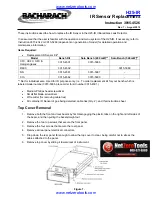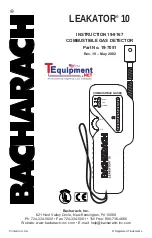
10
95-8556
2.1
Consideration of the following system location
guidelines is also recommended:
LED Visibility
Select a mounting orientation where the Open Path
Eclipse status indication LED is visible to personnel
within the area.
Module Separation Distance
The transmitter and receiver modules must be installed
directly facing each other across the area to be
protected. Physical obstructions in the direct line of
sight between the modules are not permitted. The
overall line of sight distance between the modules must
not fall outside the specified operating distance range
(refer to “Specifications” for details).
System Mounting Elevation
In all cases, the modules should be installed at the
same elevation above grade to ensure that alignment
capability and foul weather performance are not
compromised. For detection of lighter than air vapors
such as methane, installation of modules at
approximately 2 meters above grade minimizes typical
beam block conditions due to human activities, while
enabling satisfactory detection capability. For detection
of heavier than air vapors, installation of detectors below
the expected leakage source is generally
recommended unless nuisance beam blocks will occur
at an unacceptable rate. In this case, identification and
analysis of application specific conditions should be
completed to determine the optimum installation
elevation.
Sources of Heavy Contamination
Avoid locations where high levels of contaminants will
persistently be blown onto the detector windows.
Potential sources of heavy contamination include
generator / turbine exhausts, flarestacks, drilling
equipment, process vents / chimneys, etc. If sources of
heavy contamination cannot be avoided, consider fitting
extra shielding and/or providing good access for routine
cleaning.
Snow and Ice in Ambients Below –20°C
The heated optics on both modules will melt snow or ice
on the windows in ambient temperatures down to
approximately –20°C. Below this temperature, snow or
ice blown onto the window will not be melted until the
ambient temperature rises. If longterm outdoor
operation in very cold climates is intended, extra
shielding / covers are recommended to prevent
accumulation of snow and ice on the windows.
Deluge and Flooding
The modules are rated IP66 and will not be damaged by
occasional deluge or flooding. However, during such
an event, the unit will completely lose it’s IR signal and
will enter the “Beam-Block / Fault” state. In addition,
when the deluge / flooding subsides, there is the
possibility that contaminants will be left on the windows.
Install the modules away from areas particularly prone
to deluge or flooding.
Areas Prone to Subsidence and Settling
Avoid installation of the modules in areas where
problems with subsidence, settling or thawing of
permafrost can occur or cause significant movement. If
such locations cannot be avoided, the foundations of
the mounting structure should be engineered to
minimize any angular movements between the receiver
and transmitter.
Areas Prone to Earthquakes
In the event of an earthquake, there is a chance that the
modules will become misaligned with respect to each
other. As long as the modules do not suffer from direct
mechanical impact damage during an earthquake, they
should remain undamaged by such events. After an
earthquake, it is recommended that the system
alignment be checked. Antivibration mounts are
unlikely to be of any benefit and are not recommended.
Misalignment by Accidental Impact
Locations where there is a significant likelihood of
equipment, personnel or moving objects accidentally
knocking the modules out of alignment should be
avoided where possible. If such locations cannot be
avoided, measures including improved mechanical
protection and warning notices should be considered.
MODULE MOUNTING RECOMMENDATIONS
OPECL modules must be affixed to a solid, non-
vibrating structure capable of supporting a minimum of
100 lbs (46 kg), located within the system’s rated
separation distance.
In all cases, the maximum movement of the supporting
structure under all anticipated operating conditions
must be no more than ±0.25 degrees. When using a
vertical post, the post should be absolutely stable and
without vibration. Generally, when the post is set into
the ground, the portion below grade should be set in
concrete at least 1 meter deep.













































